ABSTRACT
Korea is a country that has succeeded in reforestation. Now, our people are living in green forests with various benefits. Korea Forest Service (KFS) played a major role to make forests at the current level. This article was prepared to introduce Korean forest policies that contributed to reforestation and enhanced public happiness. The focus of policies had changed according to the period. After the successful reforestation, KFS had been focusing on delivering the public benefit to the people as much as possible. As a result, the target and scope of policy was expanded. Now forest policy deals with various fields such as forest resource management, disaster prevention, and forest welfare services. In this paper, the achievements and limitations of each policy field are examined and some suggestions are also addressed. Finally, recent forest policies in response to the Korean New Deal and carbon-neutral 2050 are introduced. I hope that this artcle can help the reader understand Korea's forest policy.
Keywords: Forest policy, Reforestation, Forest service, Policy analysis
INTRODUCTION
The forest area of Korea is 6.34 million ha, accounting for 64% of the national land area. As shown in Figure 1, anyone can see the forests wherever you go in Korea. However, it wasn't like that from the beginning of the 1900s. During the Korean War, forests were destroyed, and trees near the villages were used for fuel. Deforestation had accelerated. In 1967, the Korea Forest Service (hereafter KFS) was established to effectively reforest Korean forests.
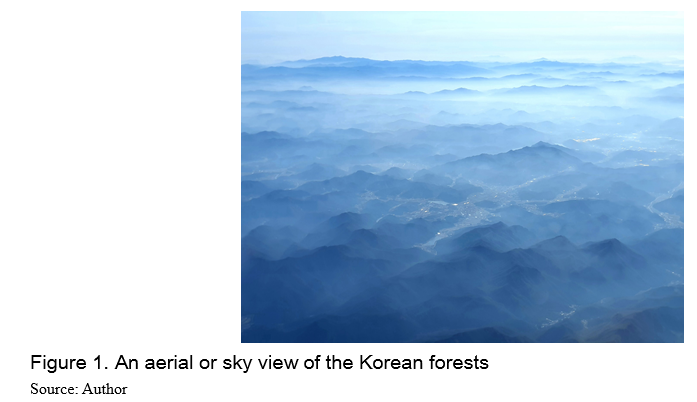
With continuous efforts of the central government, local governments and the people, Korea has succeeded in reforestation. Republic of Korea is a unique country that has succeeded in national land afforestation after World War II (UNDP, 2019). As a result of a recent analysis by the Food and Agriculture Organization of the United Nations Forestry Committee, the growth rate of Korea's forest resources including wood accumulation for the past 25 years (1990-2015) was the world's first (FAO, 2020). The continuous investments significantly increased the quantity and quality of forest resources. The timber accumulation stock, which represents the amount of wood per unit area, increased from 125㎥/ha in 2010 to 161㎥/ha in 2019 (Korea Forest Service, 2020a).
The history of forest policies so far can be divided into five periods as follows: the 1st period (1973~1987), the 2nd period (1988~1997), the 3rd period (1998~2007), the 4th period (2008~2017), and the 5th period (2018~present). This classification of the period is in accordance with the purpose of the 10-year national forest plan. KFS focused on afforestation and rehabilitation of slash-and-burn areas for greening the bare mountain during the first period. In the second period, KFS also focused on afforestation, but the purpose was changed from green to rendering to resources. A lot had changed since the 3rd period. KFS shifted its policy paradigm to sustainable forest management and had begun to consider climate change issues. And in the 4th period, KFS strengthened policies for forest welfare revitalization such as forest recreation, healing, and education service. The most recent national forest plan was established in 2017. The planning period is from 2018 to 2037, and the vision consists of the following three parts: (1) Productive forests that create jobs, (2) Welfare-enhancing forests that everyone can enjoy, and (3) Ecological forests where human and nature co-exist in harmony. In this plan, KFS has set eight performance goals (Table 1).
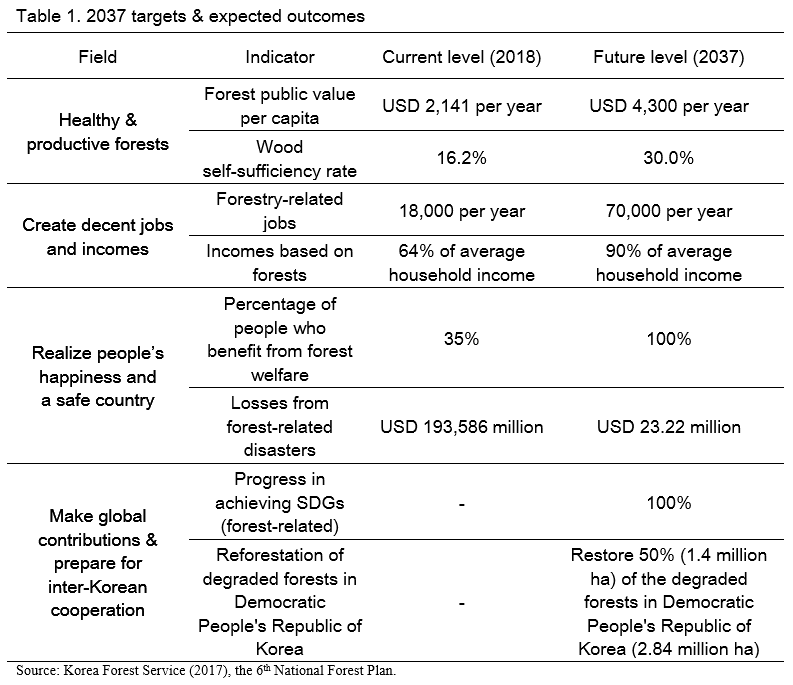
Looking back on the forest policy so far, the quantity and quality of forest policy targets have increased. Currently, 3,095 staff members, including 1,913 civil servants, are working at the KFS. Several public institutions, such as Korea Forest Welfare Institute, Korea Forestry Promotion Institute, Korea Institute of Arboretum Management, Korea Mountaineering Support Center, National Forestry Cooperative Federation, are also in charge of forest-related affairs. As the scope of forest policy has been expanded, the number of forest-related laws has reached 22. In this article, I would like to present the current status, performance and future direction of various forest policies. In addition, issues that have recently been spotlighted not only in the forestry sector but also in all sectors that will be introduced.
MAJOR ISSUES IN FOREST POLICY FIELDS
As of 2020, the budget of KFS is USD1,913 million. By field, ‘fostering and protecting forest’ accounted for the most at 57% of the total, followed by ‘expanding forest welfare services’ at 15% and ‘strengthening forest industry’ at 13%. There are several criteria for dividing forest policy fields, but in this article, I will try to point out the meaning of each field based on the budget programs as follows: (1) Nurturing forest resources and industry, (2) Promoting forest use and welfare, (3) Founding National Recreational Forest, (4) Protecting forest resources, (5) International forest cooperation, and (6) Research and development on forest science and technology. As shown in Figure 2, based on the budget ratio, ‘Nurturing forest resources and industry’ accounted for the most at 41.9%, followed by ‘Protecting forest resource’ (28.4%) and ‘Promoting forest use and welfare’ (18.8%).
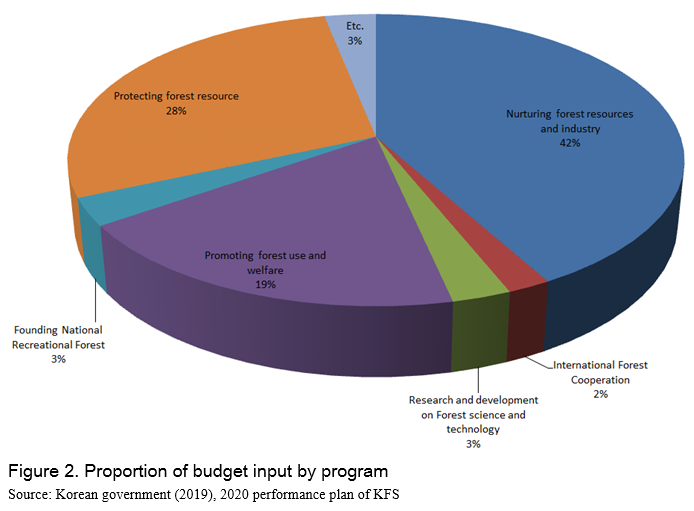
Nurturing forest resources and industry
The purpose of the program is to foster forest resources and forestry. It also enhances the economic and environmental value of forest resources. It covers the entire process of planting, caring for, and harvesting trees in the mountains. And it treats not only timber but also non-timber products such as chestnuts and shiitake. The total budget for this program is USD 732 million, accounting for 41.9% of the total forest budget. Among the unit project, ‘Fostering and managing forest resource’ (37.6%) accounts for the highest budget, followed by ‘Forest road facility’ (19.2%), ‘Supporting forestry policy fund’ (12.1%), and ‘Utilizing timber and non-timber product’ (8.4%).
For the past three years, the compound annual growth rate (hereafter CAGR) of the budget invested in this program was 2.2%, maintaining a similar level. However, there was some different pattern of increase or decrease by the unit business. The average annual growth rate of ‘Producing and managing seed and seedling’ was the highest at 55.1%, and ‘Managing debt of forestry workers’ (-9.2%) and ‘Managing state-owned property’ (-4.1%) showed a relatively large average annual decrease.
Based on the unit project, the proportion of the budget for ‘Fostering and managing forest resources’ consisting of reforestation and forestry is high, but the effectiveness is not that much. Because the proportion of artificial forests is not as high as 20% (Korea Forest Research Institute, 2011), if well managed, the proportion of it would have been higher than this (Koo et al., 2020).
In 2015, The proportion of private forests reaches 67%, but the accumulation of private forest trees is 136㎥/ha, which is smaller than those of national or public forests (Korea Forest Service, 2020). In 2019, the number of real estate owners reached 2.17 million, and owners of less than 1 ha accounted for 67.2%. In addition, the proportion of residents outside their own forest reached 55.9% (Korea Forest Service, 2018). In addition, only 24.4% of the respondents cited timber or forest product production as the main reason for forest purchase (Gallup Korea, 2015). Considering these factors, it is necessary to prepare practical support measures to encourage forest owners to participate in forest management. The forestry direct payment system can be an effective policy tool. Fortunately, a law related to the forestry direct payment system has been proposed and is under consideration.
A program that maximizes the value of forests to increase the income of foresters is the core of forest policy. However, it is judged that the value generated from the forest cannot lead to the income of foresters with the unit projects within the current program. Thus, it is necessary to link between unit projects to realize forest circulation forestry. It refers to maintaining the health of the forest ecosystem while producing wood through repeating the cycle of reforestation-forestry-harvest-reforestation. To solve the bottleneck of circulation, it is necessary to improve the overall constitution, such as renewing tree species through appropriate felling, creating a large demand for timber, and strengthening support conditions for forest management.
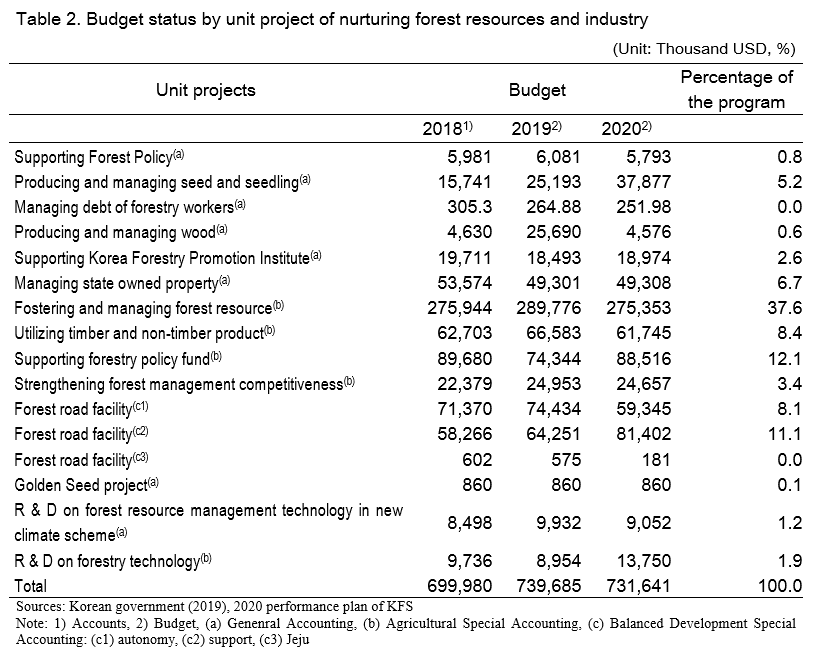
Promoting forest use and welfare
The purpose of this program is to expand the provision of forest welfare services and establish a management system for rational conservation and nature-friendly development of mountain areas. The budget invested in the program is about USD 328 million, accounting for 18.8% of the total forest budget. It consists of 8 unit projects, with the highest proportion (49.6%) of ‘Establishment of a basis for responding to fine dust reduction’, followed by ‘Providing and operating forest welfare service’ (13.6%), and ‘Creating forest recreational green space’ (12.2%).
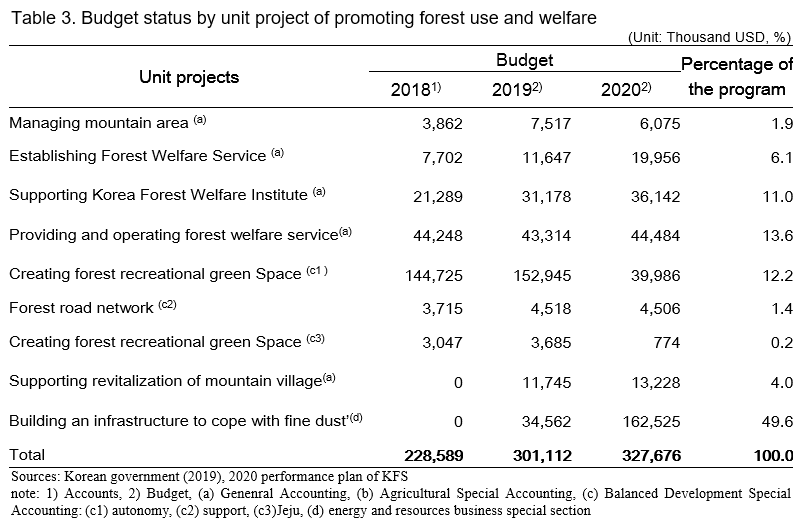
Over the past three years, the budget for the program has increased by an average of 19.7% per year. It appears to be a result of the increased public demand. Only ‘Creating forest recreational green space’ project decreased by an average of 47.4% per year, while all other unit projects increased. In 2019, ‘Supporting revitalization of mountain village’ and ’Building an infrastructure to cope with fine dust’ were newly included in the program.
Although the demand for forest welfare has been rapidly increasing, there is a concern that the demand for forest welfare services, which mainly perform outdoor activities, will decrease due to the increase in the number of days of fine dust. According to the Korea Institute of Health and Environment, the number of bad days and the highest concentration of fine dust in 2019 increased by about two times compared to 2015. In addition, the demand for forest welfare may be affected by the spread of un-tact economy due to the COVID-19 pandemic.
KFS has expanded the scope of forest welfare from existing recreation to healing, culture, and education. Various national facilities are being installed to meet the demands of each sector. As a result, there is a problem of overlapping roles between facilities and conflicts with the private sector. Nation’s intervention for providing forest welfare service is inevitable to respond to the growing demand for forest recreation, healing, and culture. This is because the provision of services entails significant costs. However, this should be limited to the initial stage, and in the long term, it is necessary to transfer the role to the private sector and focus on software development rather than hardware composition.
Founding National Recreational Forest
The program aims to contribute to the improvement of the quality of life by providing green recreation services to the people by creating and operating the national natural recreation forest. The budget invested in the program was USD 53 million, accounting for 3.1% of the total budget.
Recreational forests are divided into central government, local government, and privately-owned sites according to their ownership. There have been notable changes to this project. Since the second half of 2019, an integrated forest recreation platform (https://www.foresttrip.go.kr/main.do, see Figure 3), that allows reservations and payments for all central government, local government, and privately-owned facilities (170 places) at once, has been in operation.
The problem of market disruption is pointed out as state-owned recreational forests provide high-quality services at low prices. Following the operation of Forest Outing, short-term damage to private and shared recreational forests that provide relatively low-quality services is expected. Therefore, the National Recreational Forest does not need to meet the growing demand for recreation. At present, there are 170 natural recreation forests installed across the country. Rather than creating a new natural recreation forest, it is judged that the method through linkage with shared and private recreational forests and coexistence is more effective (Koo et al, 2019).
The facility- and accommodation-oriented forest recreation service has problems such as an increase in facility maintenance costs and insufficient differentiation from similar facilities. Also, it is considered a problem that policy projects focus more on creation rather than management.

Protecting forest resource
The purpose of this program is to protect people's lives and property by maintaining a healthy forest environment through prevention, control, and restoration of forest disasters such as forest fires, pests, and landslides.
The input budget for the program is USD 496 million, accounting for 28.4% of the total forest budget. Among the unit projects, the proportion of input to ‘Preventing and managing land slide’ was the highest at 25.6%, followed by ‘Managing forest disaster’ (21.8%), ‘Preventing and managing forest pest’ (16.2%), and helicopters (11.6%). The average annual growth rate for the recent three-year program was -1.5%, maintaining a similar level. However, the increase and decrease of the budget for each unit project were different. ‘Preventing and managing forest fire’ project increased (65.5%), and ‘Preventing and managing land slide’ (-13.4%) and ‘Preventing and managing forest pest’ (-8.7%) decreased.
The number of dry days and strong winds have increased due to climate change, resulting in larger forest fires. The risk of artificial fire is increasing due to an increase in hikers and an increase in forest welfare demand. With the arrival of the inspection cycle of the used helicopter, the demand for repair is increasing. This program is a core project of forest policies to protect people's lives and promote safety. Although the policy is effective in controlling landslides, forest fires, and pests, continuous policy input is necessary considering the increased possibility and expected size of forest disasters due to climate change.
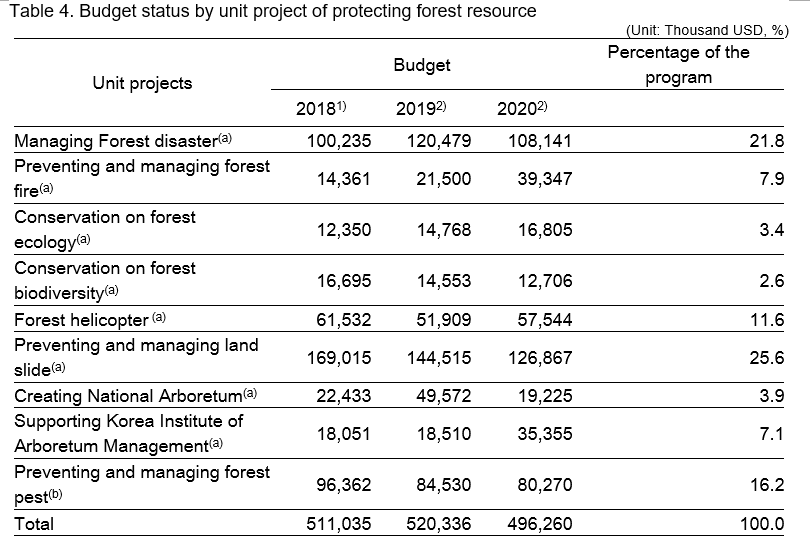
International forest cooperation
The purpose of this program is to contribute to the conservation of the global environment through forestry cooperation and to strengthen the response to the export and trade of forest products. The total budget for the program is USD 34 million, accounting for 2.0% of the total. By unit project, ‘International forest cooperation’ accounted for 82.8%, and ‘Promoting forest product export’ accounted for 17.2%. Over the past three years, the average annual growth rate of the budget invested in the program was 21.7%, mainly due to the increase in the budget for international forest cooperation unit projects. This is because the budget for the hosting of the World Forestry Congress in 2021 (USD 430 thousand/year) and the inter-Korean forest cooperation (USD 456 thousand/year) promoted from 2019 has increased.
In February 2019, after the breakdown of the North Korea-U.S. summit in Hanoi, inter-Korean relations were strained. Accordingly, the inter-Korean forest cooperation project, which was promoted after the Pyongyang Joint Declaration on September 19, 2018, is also stagnant. On October 25, 2019, the Korean government announced that it would renounce its developing country status in the World Trade Organization (WTO). It is expected to have an impact on the relationship between the import and export of forest products.

Research and development on forest science and technology
The purpose of this program is to develop forest science and technology to improve the quality of forest policies related to enhancing the competitiveness of the forest industry and promoting international research cooperation. The total budget for the program is USD 47 million, accounting for 2.7% of the total forest budget.
The unit projects are the informatization and development of forest science and technology. Development is a project to support forestry sites and disseminate practical technology, while informatization is a project to systematize accumulated knowledge and technology and service it to the public. For the last three years, the average annual growth rate of the budget invested in the program was 0.3%, maintaining a similar level. 96.9% of the budget was spent on the development part. For the last three years, the average annual growth rate of the budget invested in the program was 0.3%, maintaining a similar level.
Following the government's key to realizing social values tangible to the people, there is a growing demand for disclosure of R&D results and enhancement of usability. In addition, there is a problem of developing similar technologies by other research institutes. Therefore, it is necessary to strengthen the transparency and feedback of forest science and technology information disclosure.
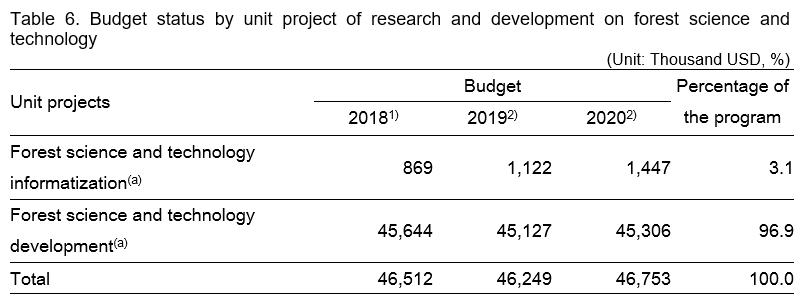
RECENT ISSUES IN KOREAN FOREST SECTORS
Korean new deal and 2050 carbon neutrality
The Korean government announced the ‘Korean New Deal’ to not only overcome the economic crisis brought about by the COVID-19 pandemic but also design a new future for the country. It is based on the two axes of the ‘Digital New Deal’ and the ‘Green New Deal’, and based on the ‘strengthening of an inclusive social safety net.’ KFS was agile in planning K-Forest as a means to support the realization of the Korean New Deal. The vision is ‘a new daily life in the forest.’ Goals of K-Forest are creating jobs, promoting smart forestry, and providing forest education and healing opportunities in the living area. The structure of the plan including 4 strategies and 16 policy tasks is shown in Table 7. As shown in Figure 4, KFS seems to have tried to maximize the use of forests in daily life through K-forest.
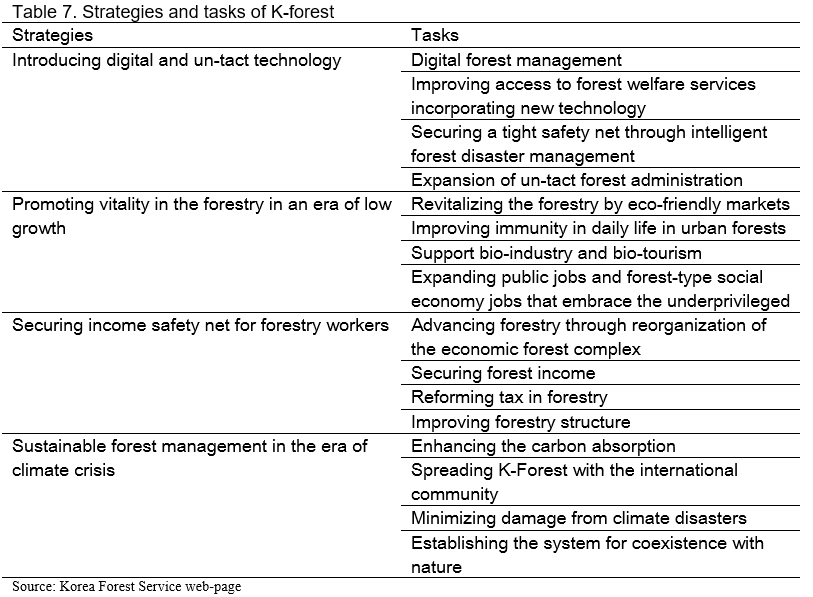
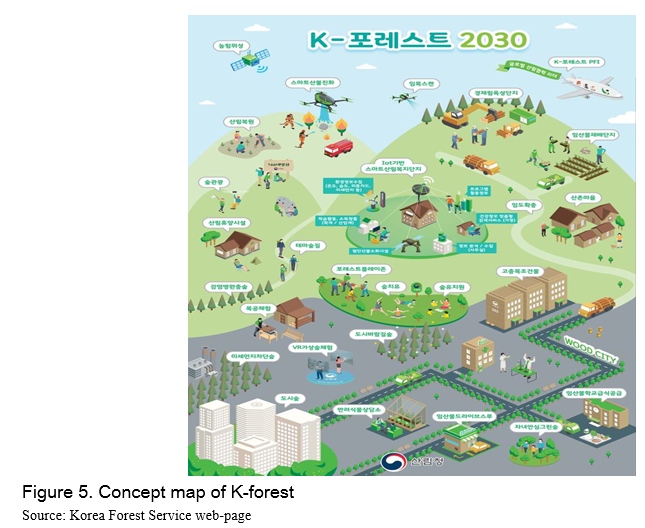
In 2020, the Korean government declared 2050 carbon neutrality, and on December 7th, the related ministries announced a joint implementation strategy. It was specified in the country's major future strategy to enhance the function of 'forests' as a key carbon sink. In January 2021, KFS preemptively prepared the ‘2050 Carbon Neutral Forest Sector Promotion Strategy’ to enhance the carbon absorption and storage function of forests. It has established a representative goal of contributing 34 million tons of carbon neutrality by 2050 through planting 3 billion trees over 30 years. Four policy directions were prepared: (1) Strengthening the carbon absorption capacity of forests, (2) Expanding new forest carbon sinks, (3) Promoting the use of wood and forest biomass, and (4) Conserving and restoring forest carbon sinks. However, something unexpected happens. There were criticisms from environmental groups that the existing forest should be removed to plant new trees. The Korea Forest Service formed a consultative body and decided to discuss the carbon-neutral strategy from the beginning.
CONCLUSION
So far, the historical changes and present meanings of Koren forest policy have been reviewed. Korean forest policy has been changed not only in response to the status of forests but also in response to the diverse needs of the people. Our society is now facing numerous mega-trends such as COVID-19, carbon neutrality, low growth, and dramatic demographic changes. As it has been so far, Korean forest policy will evolve by changing its shape agilely in response to mega-trends. I'm curious to see what forestry and forestry policy will look like in 2050 that promises to be carbon neutral. I end this article with the hope that it can help the reader understand Korea's forest policy.
REFERENCES
FAO (2020), COFO’s report “Forest Futures in the Asia-Pacific Region.
Gallup Korea (2015), A survey on public awareness about forests, Korea Forest Service.
Koo Jachoon, Seok Hyundeok, Byun Seongyeon (2019), Policy tasks for improving demand-supply conditions of forest recreation infrastructure, Korea Rural Economic Institute.
Koo Jachoon, Min Kyug-taek, Kim Nahyun (2020), Management structure improvement plan to enhance forest public value, Presidential special committee on agriculture and fishing affair.
Korea Forest Research Institute, 2011, the 5th National Forest Inventory Report.
Korea Forest Service (2017), The 6th National forest plan.
Korea Forest Service (2018), 2017 National Mountain Ownership Status.
Korea Forest Service (2020a), 2020 Statisitical Yearbook of Forestry
Korea Forest Service (2020b), K-Forest Promotion Plan.
Korea Forest Service (2021), 2050 Carbon Neutral Forest Sector Promotion Strategy.
Korean government (2019), 2020 performance plan of Korea Forest Service.
Korean government (2020), Korean New Deal plan.
Korean government (2020), 2050 Carbon Neutral Strategy.
UNDP (2019), Sustainable Development Goals Policy Brief Series No.10 Sharing Korea’s Experience in Sustainable Forestry: Possible Applications in Developing Countries


Korean Forest Policy and Current Issues
ABSTRACT
Korea is a country that has succeeded in reforestation. Now, our people are living in green forests with various benefits. Korea Forest Service (KFS) played a major role to make forests at the current level. This article was prepared to introduce Korean forest policies that contributed to reforestation and enhanced public happiness. The focus of policies had changed according to the period. After the successful reforestation, KFS had been focusing on delivering the public benefit to the people as much as possible. As a result, the target and scope of policy was expanded. Now forest policy deals with various fields such as forest resource management, disaster prevention, and forest welfare services. In this paper, the achievements and limitations of each policy field are examined and some suggestions are also addressed. Finally, recent forest policies in response to the Korean New Deal and carbon-neutral 2050 are introduced. I hope that this artcle can help the reader understand Korea's forest policy.
Keywords: Forest policy, Reforestation, Forest service, Policy analysis
INTRODUCTION
The forest area of Korea is 6.34 million ha, accounting for 64% of the national land area. As shown in Figure 1, anyone can see the forests wherever you go in Korea. However, it wasn't like that from the beginning of the 1900s. During the Korean War, forests were destroyed, and trees near the villages were used for fuel. Deforestation had accelerated. In 1967, the Korea Forest Service (hereafter KFS) was established to effectively reforest Korean forests.
With continuous efforts of the central government, local governments and the people, Korea has succeeded in reforestation. Republic of Korea is a unique country that has succeeded in national land afforestation after World War II (UNDP, 2019). As a result of a recent analysis by the Food and Agriculture Organization of the United Nations Forestry Committee, the growth rate of Korea's forest resources including wood accumulation for the past 25 years (1990-2015) was the world's first (FAO, 2020). The continuous investments significantly increased the quantity and quality of forest resources. The timber accumulation stock, which represents the amount of wood per unit area, increased from 125㎥/ha in 2010 to 161㎥/ha in 2019 (Korea Forest Service, 2020a).
The history of forest policies so far can be divided into five periods as follows: the 1st period (1973~1987), the 2nd period (1988~1997), the 3rd period (1998~2007), the 4th period (2008~2017), and the 5th period (2018~present). This classification of the period is in accordance with the purpose of the 10-year national forest plan. KFS focused on afforestation and rehabilitation of slash-and-burn areas for greening the bare mountain during the first period. In the second period, KFS also focused on afforestation, but the purpose was changed from green to rendering to resources. A lot had changed since the 3rd period. KFS shifted its policy paradigm to sustainable forest management and had begun to consider climate change issues. And in the 4th period, KFS strengthened policies for forest welfare revitalization such as forest recreation, healing, and education service. The most recent national forest plan was established in 2017. The planning period is from 2018 to 2037, and the vision consists of the following three parts: (1) Productive forests that create jobs, (2) Welfare-enhancing forests that everyone can enjoy, and (3) Ecological forests where human and nature co-exist in harmony. In this plan, KFS has set eight performance goals (Table 1).
Looking back on the forest policy so far, the quantity and quality of forest policy targets have increased. Currently, 3,095 staff members, including 1,913 civil servants, are working at the KFS. Several public institutions, such as Korea Forest Welfare Institute, Korea Forestry Promotion Institute, Korea Institute of Arboretum Management, Korea Mountaineering Support Center, National Forestry Cooperative Federation, are also in charge of forest-related affairs. As the scope of forest policy has been expanded, the number of forest-related laws has reached 22. In this article, I would like to present the current status, performance and future direction of various forest policies. In addition, issues that have recently been spotlighted not only in the forestry sector but also in all sectors that will be introduced.
MAJOR ISSUES IN FOREST POLICY FIELDS
As of 2020, the budget of KFS is USD1,913 million. By field, ‘fostering and protecting forest’ accounted for the most at 57% of the total, followed by ‘expanding forest welfare services’ at 15% and ‘strengthening forest industry’ at 13%. There are several criteria for dividing forest policy fields, but in this article, I will try to point out the meaning of each field based on the budget programs as follows: (1) Nurturing forest resources and industry, (2) Promoting forest use and welfare, (3) Founding National Recreational Forest, (4) Protecting forest resources, (5) International forest cooperation, and (6) Research and development on forest science and technology. As shown in Figure 2, based on the budget ratio, ‘Nurturing forest resources and industry’ accounted for the most at 41.9%, followed by ‘Protecting forest resource’ (28.4%) and ‘Promoting forest use and welfare’ (18.8%).
Nurturing forest resources and industry
The purpose of the program is to foster forest resources and forestry. It also enhances the economic and environmental value of forest resources. It covers the entire process of planting, caring for, and harvesting trees in the mountains. And it treats not only timber but also non-timber products such as chestnuts and shiitake. The total budget for this program is USD 732 million, accounting for 41.9% of the total forest budget. Among the unit project, ‘Fostering and managing forest resource’ (37.6%) accounts for the highest budget, followed by ‘Forest road facility’ (19.2%), ‘Supporting forestry policy fund’ (12.1%), and ‘Utilizing timber and non-timber product’ (8.4%).
For the past three years, the compound annual growth rate (hereafter CAGR) of the budget invested in this program was 2.2%, maintaining a similar level. However, there was some different pattern of increase or decrease by the unit business. The average annual growth rate of ‘Producing and managing seed and seedling’ was the highest at 55.1%, and ‘Managing debt of forestry workers’ (-9.2%) and ‘Managing state-owned property’ (-4.1%) showed a relatively large average annual decrease.
Based on the unit project, the proportion of the budget for ‘Fostering and managing forest resources’ consisting of reforestation and forestry is high, but the effectiveness is not that much. Because the proportion of artificial forests is not as high as 20% (Korea Forest Research Institute, 2011), if well managed, the proportion of it would have been higher than this (Koo et al., 2020).
In 2015, The proportion of private forests reaches 67%, but the accumulation of private forest trees is 136㎥/ha, which is smaller than those of national or public forests (Korea Forest Service, 2020). In 2019, the number of real estate owners reached 2.17 million, and owners of less than 1 ha accounted for 67.2%. In addition, the proportion of residents outside their own forest reached 55.9% (Korea Forest Service, 2018). In addition, only 24.4% of the respondents cited timber or forest product production as the main reason for forest purchase (Gallup Korea, 2015). Considering these factors, it is necessary to prepare practical support measures to encourage forest owners to participate in forest management. The forestry direct payment system can be an effective policy tool. Fortunately, a law related to the forestry direct payment system has been proposed and is under consideration.
A program that maximizes the value of forests to increase the income of foresters is the core of forest policy. However, it is judged that the value generated from the forest cannot lead to the income of foresters with the unit projects within the current program. Thus, it is necessary to link between unit projects to realize forest circulation forestry. It refers to maintaining the health of the forest ecosystem while producing wood through repeating the cycle of reforestation-forestry-harvest-reforestation. To solve the bottleneck of circulation, it is necessary to improve the overall constitution, such as renewing tree species through appropriate felling, creating a large demand for timber, and strengthening support conditions for forest management.
Promoting forest use and welfare
The purpose of this program is to expand the provision of forest welfare services and establish a management system for rational conservation and nature-friendly development of mountain areas. The budget invested in the program is about USD 328 million, accounting for 18.8% of the total forest budget. It consists of 8 unit projects, with the highest proportion (49.6%) of ‘Establishment of a basis for responding to fine dust reduction’, followed by ‘Providing and operating forest welfare service’ (13.6%), and ‘Creating forest recreational green space’ (12.2%).
Over the past three years, the budget for the program has increased by an average of 19.7% per year. It appears to be a result of the increased public demand. Only ‘Creating forest recreational green space’ project decreased by an average of 47.4% per year, while all other unit projects increased. In 2019, ‘Supporting revitalization of mountain village’ and ’Building an infrastructure to cope with fine dust’ were newly included in the program.
Although the demand for forest welfare has been rapidly increasing, there is a concern that the demand for forest welfare services, which mainly perform outdoor activities, will decrease due to the increase in the number of days of fine dust. According to the Korea Institute of Health and Environment, the number of bad days and the highest concentration of fine dust in 2019 increased by about two times compared to 2015. In addition, the demand for forest welfare may be affected by the spread of un-tact economy due to the COVID-19 pandemic.
KFS has expanded the scope of forest welfare from existing recreation to healing, culture, and education. Various national facilities are being installed to meet the demands of each sector. As a result, there is a problem of overlapping roles between facilities and conflicts with the private sector. Nation’s intervention for providing forest welfare service is inevitable to respond to the growing demand for forest recreation, healing, and culture. This is because the provision of services entails significant costs. However, this should be limited to the initial stage, and in the long term, it is necessary to transfer the role to the private sector and focus on software development rather than hardware composition.
Founding National Recreational Forest
The program aims to contribute to the improvement of the quality of life by providing green recreation services to the people by creating and operating the national natural recreation forest. The budget invested in the program was USD 53 million, accounting for 3.1% of the total budget.
Recreational forests are divided into central government, local government, and privately-owned sites according to their ownership. There have been notable changes to this project. Since the second half of 2019, an integrated forest recreation platform (https://www.foresttrip.go.kr/main.do, see Figure 3), that allows reservations and payments for all central government, local government, and privately-owned facilities (170 places) at once, has been in operation.
The problem of market disruption is pointed out as state-owned recreational forests provide high-quality services at low prices. Following the operation of Forest Outing, short-term damage to private and shared recreational forests that provide relatively low-quality services is expected. Therefore, the National Recreational Forest does not need to meet the growing demand for recreation. At present, there are 170 natural recreation forests installed across the country. Rather than creating a new natural recreation forest, it is judged that the method through linkage with shared and private recreational forests and coexistence is more effective (Koo et al, 2019).
The facility- and accommodation-oriented forest recreation service has problems such as an increase in facility maintenance costs and insufficient differentiation from similar facilities. Also, it is considered a problem that policy projects focus more on creation rather than management.
Protecting forest resource
The purpose of this program is to protect people's lives and property by maintaining a healthy forest environment through prevention, control, and restoration of forest disasters such as forest fires, pests, and landslides.
The input budget for the program is USD 496 million, accounting for 28.4% of the total forest budget. Among the unit projects, the proportion of input to ‘Preventing and managing land slide’ was the highest at 25.6%, followed by ‘Managing forest disaster’ (21.8%), ‘Preventing and managing forest pest’ (16.2%), and helicopters (11.6%). The average annual growth rate for the recent three-year program was -1.5%, maintaining a similar level. However, the increase and decrease of the budget for each unit project were different. ‘Preventing and managing forest fire’ project increased (65.5%), and ‘Preventing and managing land slide’ (-13.4%) and ‘Preventing and managing forest pest’ (-8.7%) decreased.
The number of dry days and strong winds have increased due to climate change, resulting in larger forest fires. The risk of artificial fire is increasing due to an increase in hikers and an increase in forest welfare demand. With the arrival of the inspection cycle of the used helicopter, the demand for repair is increasing. This program is a core project of forest policies to protect people's lives and promote safety. Although the policy is effective in controlling landslides, forest fires, and pests, continuous policy input is necessary considering the increased possibility and expected size of forest disasters due to climate change.
International forest cooperation
The purpose of this program is to contribute to the conservation of the global environment through forestry cooperation and to strengthen the response to the export and trade of forest products. The total budget for the program is USD 34 million, accounting for 2.0% of the total. By unit project, ‘International forest cooperation’ accounted for 82.8%, and ‘Promoting forest product export’ accounted for 17.2%. Over the past three years, the average annual growth rate of the budget invested in the program was 21.7%, mainly due to the increase in the budget for international forest cooperation unit projects. This is because the budget for the hosting of the World Forestry Congress in 2021 (USD 430 thousand/year) and the inter-Korean forest cooperation (USD 456 thousand/year) promoted from 2019 has increased.
In February 2019, after the breakdown of the North Korea-U.S. summit in Hanoi, inter-Korean relations were strained. Accordingly, the inter-Korean forest cooperation project, which was promoted after the Pyongyang Joint Declaration on September 19, 2018, is also stagnant. On October 25, 2019, the Korean government announced that it would renounce its developing country status in the World Trade Organization (WTO). It is expected to have an impact on the relationship between the import and export of forest products.
Research and development on forest science and technology
The purpose of this program is to develop forest science and technology to improve the quality of forest policies related to enhancing the competitiveness of the forest industry and promoting international research cooperation. The total budget for the program is USD 47 million, accounting for 2.7% of the total forest budget.
The unit projects are the informatization and development of forest science and technology. Development is a project to support forestry sites and disseminate practical technology, while informatization is a project to systematize accumulated knowledge and technology and service it to the public. For the last three years, the average annual growth rate of the budget invested in the program was 0.3%, maintaining a similar level. 96.9% of the budget was spent on the development part. For the last three years, the average annual growth rate of the budget invested in the program was 0.3%, maintaining a similar level.
Following the government's key to realizing social values tangible to the people, there is a growing demand for disclosure of R&D results and enhancement of usability. In addition, there is a problem of developing similar technologies by other research institutes. Therefore, it is necessary to strengthen the transparency and feedback of forest science and technology information disclosure.

RECENT ISSUES IN KOREAN FOREST SECTORS
Korean new deal and 2050 carbon neutrality
The Korean government announced the ‘Korean New Deal’ to not only overcome the economic crisis brought about by the COVID-19 pandemic but also design a new future for the country. It is based on the two axes of the ‘Digital New Deal’ and the ‘Green New Deal’, and based on the ‘strengthening of an inclusive social safety net.’ KFS was agile in planning K-Forest as a means to support the realization of the Korean New Deal. The vision is ‘a new daily life in the forest.’ Goals of K-Forest are creating jobs, promoting smart forestry, and providing forest education and healing opportunities in the living area. The structure of the plan including 4 strategies and 16 policy tasks is shown in Table 7. As shown in Figure 4, KFS seems to have tried to maximize the use of forests in daily life through K-forest.
In 2020, the Korean government declared 2050 carbon neutrality, and on December 7th, the related ministries announced a joint implementation strategy. It was specified in the country's major future strategy to enhance the function of 'forests' as a key carbon sink. In January 2021, KFS preemptively prepared the ‘2050 Carbon Neutral Forest Sector Promotion Strategy’ to enhance the carbon absorption and storage function of forests. It has established a representative goal of contributing 34 million tons of carbon neutrality by 2050 through planting 3 billion trees over 30 years. Four policy directions were prepared: (1) Strengthening the carbon absorption capacity of forests, (2) Expanding new forest carbon sinks, (3) Promoting the use of wood and forest biomass, and (4) Conserving and restoring forest carbon sinks. However, something unexpected happens. There were criticisms from environmental groups that the existing forest should be removed to plant new trees. The Korea Forest Service formed a consultative body and decided to discuss the carbon-neutral strategy from the beginning.
CONCLUSION
So far, the historical changes and present meanings of Koren forest policy have been reviewed. Korean forest policy has been changed not only in response to the status of forests but also in response to the diverse needs of the people. Our society is now facing numerous mega-trends such as COVID-19, carbon neutrality, low growth, and dramatic demographic changes. As it has been so far, Korean forest policy will evolve by changing its shape agilely in response to mega-trends. I'm curious to see what forestry and forestry policy will look like in 2050 that promises to be carbon neutral. I end this article with the hope that it can help the reader understand Korea's forest policy.
REFERENCES
FAO (2020), COFO’s report “Forest Futures in the Asia-Pacific Region.
Gallup Korea (2015), A survey on public awareness about forests, Korea Forest Service.
Koo Jachoon, Seok Hyundeok, Byun Seongyeon (2019), Policy tasks for improving demand-supply conditions of forest recreation infrastructure, Korea Rural Economic Institute.
Koo Jachoon, Min Kyug-taek, Kim Nahyun (2020), Management structure improvement plan to enhance forest public value, Presidential special committee on agriculture and fishing affair.
Korea Forest Research Institute, 2011, the 5th National Forest Inventory Report.
Korea Forest Service (2017), The 6th National forest plan.
Korea Forest Service (2018), 2017 National Mountain Ownership Status.
Korea Forest Service (2020a), 2020 Statisitical Yearbook of Forestry
Korea Forest Service (2020b), K-Forest Promotion Plan.
Korea Forest Service (2021), 2050 Carbon Neutral Forest Sector Promotion Strategy.
Korean government (2019), 2020 performance plan of Korea Forest Service.
Korean government (2020), Korean New Deal plan.
Korean government (2020), 2050 Carbon Neutral Strategy.
UNDP (2019), Sustainable Development Goals Policy Brief Series No.10 Sharing Korea’s Experience in Sustainable Forestry: Possible Applications in Developing Countries